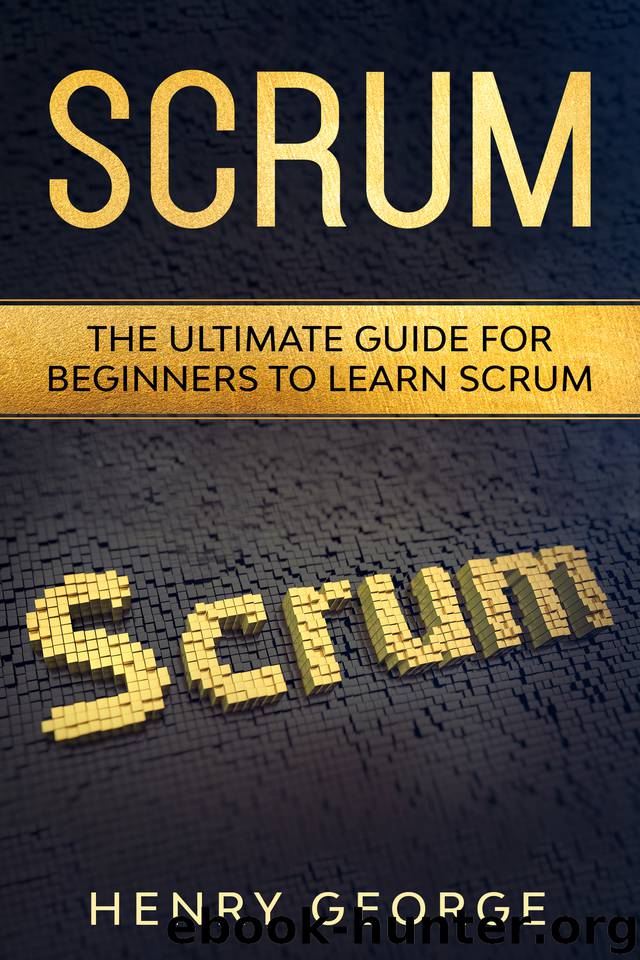Scrum: The Ultimate Guide for Beginners to Learn Scrum by George Henry

Author:George, Henry [George, Henry]
Language: eng
Format: epub
Published: 2020-01-22T16:00:00+00:00
Chapter 7 - Management in Scrum
When a company wants to have a new product or create a new system, they usually hire someone that can make the process faster and efficient. If they choose to assign that role to someone from their internal system, most often that role is given to the head of the department. Contrarily for the companies that are into the product market, they often assign this job to their product managers. In Scrum, this person is called the Scrum Master. To make the best possible formulation of the project and perform the most effective execution, the Product owner (usually CEO) helps IT and engineering departments in terms of staffing and support. When it comes to Scrum management, the first step is to have a project manager or Scrum master that will closely work with the product owner. The scrum master has the role of coach and he or she forms the teams. During the whole process, Scrum master provides guidance and individual coaching to the team and helps in optimizing the productivity of the development team in general. Collaboration between the Product Owner and Scrum Master is significant for maximizing ROI and for controlling the deliverables at the same time.
When it comes to deliverables, the Product Owner has control on the macro level while the Scrum master uses this to help the development team to self-organize on a micro-level. Just like in earlier Scrum implementations, the Product Owner is the person that needs to develop a plan, or rather a roadmap that everyone else will follow. This plan doesn’t need to have all the details just the most important elements. All other details depend on functionality and forecast of goal descriptions and its release. Although this first version of the plan should be followed, it changes throughout the project and most often these changes are made daily.
The role of the Product Owner is also to exert risk reduction and control on an empirical basis and as a response to the reality of the project. This empirical system is based on the premise that the Product owner won’t try to fit that reality into his or her initial plan, on the contrary, the Product Owner is supposed to be able to perceive the reality of the project and make decisions according to that perception. Like every project in Scrum, iterations are the main way of running the development process. Increments need to be delivered by the end of each sprint, and the Product owner is responsible for managing the business conditions for the project, technology that needs to be used and results that he or she needs from the development team. This information needs to be provided by the Product Owner in detail and at the end of every iteration. The plans that the Product owner delivers for the sprint represents empirical evidence of what development team has achieved and what needs to be done yet.
Mechanisms of control using frequent inspection and techniques for adaptation are also uncommon for many IT projects.
Download
This site does not store any files on its server. We only index and link to content provided by other sites. Please contact the content providers to delete copyright contents if any and email us, we'll remove relevant links or contents immediately.
| Coding Theory | Localization |
| Logic | Object-Oriented Design |
| Performance Optimization | Quality Control |
| Reengineering | Robohelp |
| Software Development | Software Reuse |
| Structured Design | Testing |
| Tools | UML |
The Mikado Method by Ola Ellnestam Daniel Brolund(20603)
Hello! Python by Anthony Briggs(19899)
Secrets of the JavaScript Ninja by John Resig Bear Bibeault(18208)
Dependency Injection in .NET by Mark Seemann(18108)
The Well-Grounded Java Developer by Benjamin J. Evans Martijn Verburg(17575)
OCA Java SE 8 Programmer I Certification Guide by Mala Gupta(17421)
Kotlin in Action by Dmitry Jemerov(17183)
Adobe Camera Raw For Digital Photographers Only by Rob Sheppard(16930)
Algorithms of the Intelligent Web by Haralambos Marmanis;Dmitry Babenko(16234)
Grails in Action by Glen Smith Peter Ledbrook(15390)
Test-Driven iOS Development with Swift 4 by Dominik Hauser(10393)
Becoming a Dynamics 365 Finance and Supply Chain Solution Architect by Brent Dawson(8055)
Microservices with Go by Alexander Shuiskov(7819)
Practical Design Patterns for Java Developers by Miroslav Wengner(7719)
Test Automation Engineering Handbook by Manikandan Sambamurthy(7671)
Angular Projects - Third Edition by Aristeidis Bampakos(7159)
The Art of Crafting User Stories by The Art of Crafting User Stories(6611)
NetSuite for Consultants - Second Edition by Peter Ries(6533)
Demystifying Cryptography with OpenSSL 3.0 by Alexei Khlebnikov(6305)
